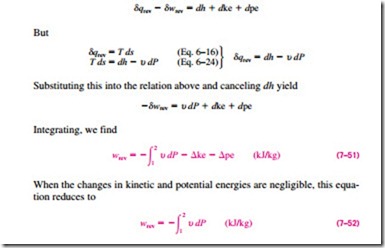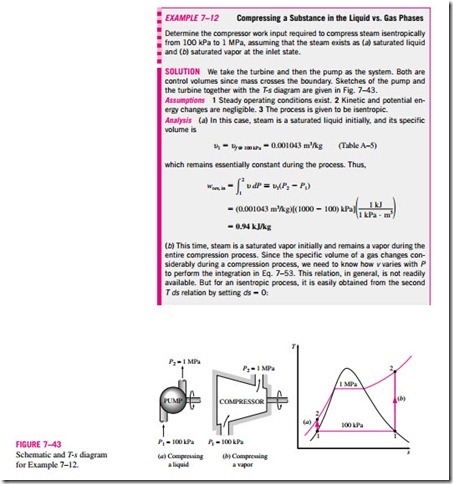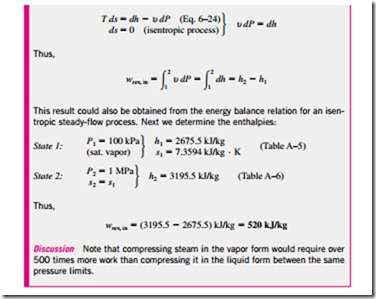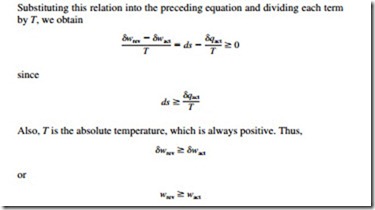■ REVERSIBLE STEADY-FLOW WORK
The work done during a process depends on the path followed as well as on the properties at the end states. Recall that reversible (quasi-equilibrium) moving boundary work associated with closed systems is expressed in terms of the fluid properties as
We mentioned that the quasi-equilibrium work interactions lead to the maxi- mum work output for work-producing devices and the minimum work input for work-consuming devices.
It would also be very insightful to express the work associated with steady- flow devices in terms of fluid properties.
Taking the positive direction of work to be from the system (work output), the energy balance for a steady-flow device undergoing an internally reversible process can be expressed in differential form as
Equations 7–51 and 7–52 are relations for the reversible work output associated with an internally reversible process in a steady-flow device. They will give a negative result when work is done on the system. To avoid the negative sign, Eq. 7–51 can be written for work input to steady-flow devices such as compressors and pumps as
The resemblance between the u dP in these relations and P du is striking. They should not be confused with each other, however, since P du is associated with reversible boundary work in closed systems (Fig. 7–41).
Obviously, one needs to know u as a function of P for the given process to perform the integration. When the working fluid is an incompressible fluid, the specific volume u remains constant during the process and can be taken out of the integration. Then Eq. 7–51 simplifies to
which is known as the Bernoulli equation in fluid mechanics. It is developed for an internally reversible process and thus is applicable to incompressible fluids that involve no irreversibilities such as friction or shock waves. This equation can be modified, however, to incorporate these effects.
Equation 7–52 has far-reaching implications in engineering regarding de- vices that produce or consume work steadily such as turbines, compressors, and pumps. It is obvious from this equation that the reversible steady-flow work is closely associated with the specific volume of the fluid flowing through the device. The larger the specific volume, the larger the reversible work produced or consumed by the steady-flow device (Fig. 7–42). This conclusion is equally valid for actual steady-flow devices. Therefore, every effort should be made to keep the specific volume of a fluid as small as possible during a compression process to minimize the work input and as large as possible during an expansion process to maximize the work output.
In steam or gas power plants, the pressure rise in the pump or compressor is equal to the pressure drop in the turbine if we disregard the pressure losses in various other components. In steam power plants, the pump handles liquid, which has a very small specific volume, and the turbine handles vapor, whose specific volume is many times larger. Therefore, the work output of the turbine is much larger than the work input to the pump. This is one of the rea- sons for the overwhelming popularity of steam power plants in electric power generation.
If we were to compress the steam exiting the turbine back to the turbine in- let pressure before cooling it first in the condenser in order to “save” the heat rejected, we would have to supply all the work produced by the turbine back to the compressor. In reality, the required work input would be even greater than the work output of the turbine because of the irreversibilities present in both processes.
In gas power plants, the working fluid (typically air) is compressed in the gas phase, and a considerable portion of the work output of the turbine is consumed by the compressor. As a result, a gas power plant delivers less net work per unit mass of the working fluid.
Proof that Steady-Flow Devices Deliver the Most and Consume the Least Work when the Process Is Reversible
We have shown in Chap. 6 that cyclic devices (heat engines, refrigerators, and heat pumps) deliver the most work and consume the least when reversible processes are used. Now we will demonstrate that this is also the case for individual devices such as turbines and compressors in steady operation.
Consider two steady-flow devices, one reversible and the other irreversible, operating between the same inlet and exit states. Again taking heat transfer to the system and work done by the system to be positive quantities, the energy balance for each of these devices can be expressed in the differential form as
Therefore, work-producing devices such as turbines (w is positive) deliver more work, and work-consuming devices such as pumps and compressors (w is negative) require less work when they operate reversibly (Fig. 7–44).






